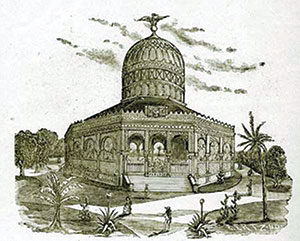During the second half of the 19th century, not long after the United States gained significant Mexican territory as a result of the Mexican-American War, relations between the two countries were severely fractured. However, after his appointment in 1876, newly elected Mexican President Porfirio Díaz sought to change this dynamic. One of Díaz’s top priorities as president was to establish a lucrative and prosperous relationship between Mexico and the United States. The World’s Industrial and Cotton Centennial Exposition of 1884 in New Orleans offered a great opportunity for President Díaz to showcase Mexican culture and help improve Mexico’s relationship with the United States.
Díaz sent an instrumental group to New Orleans representing Mexico, referred to in some sources as the Great Mexican Band and in others as The Celebrated Mexican Military Band. However, the real name of the group was The Band of the Eighth Mexican Cavalry. Thanks to an 1885 book by Herbert S. Fairall, The World’s Industrial and Cotton Centennial Exposition, New Orleans, we have first hand accounts of the important role this ensemble had at the fair. The Mexican Band was not limited to performances representing Mexico. It became a resident ensemble at the fair performing at many important events throughout the exhibition. For example, the band performed during the ceremony of the arrival of the Liberty Bell from Philadelphia to New Orleans. It also played at many of the opening ceremonies celebrating states such as Arkansas and Connecticut.
Mexico was favored by fair organizers, receiving an astonishing 250,000 square foot space for its exhibit. This was the most Mexico had been given at any world fair, including the one at Philadelphia eight years earlier, where it only got 5,000 square feet. President Díaz spared no expense in lavishly representing Mexico. The Mexican exhibit hall was the most beautiful of all, according to many eyewitness accounts. The building had a Moorish architectural style and was nicknamed the Alhambra of Mexico. The structure was so popular that it was rebuilt later in Mexico City. This beautiful structure served as the focal point of Mexican presence at the fair, but most importantly as the place to showcase performances by its ambassadorial musical jewel, The Great Mexican Band. The Band had an important role in the Opening Day ceremonies of the fair. An eyewitness account recalls an unprecedented grandeur during opening day.

The Alhambra of Mexico site of the Mexican Exhibit at the fair.
There were two great bands of music, representing the grandest achievements in this direction of the United States and Mexico. The music hall decorated with brilliant flags, banners and state shields was packed to its utmost capacity, a sea of upturned faces looked anxiously for the next step in the exercises of “opening day.” Currier’s Great Band played a “Grand Exposition March” dedicated to Director, General Burke. A few moments later the Mexican Band rendered a beautiful selection, after which the Grand Marshal of the Day, Generall J. Behan, opened the ceremonies by announcing what the first exercise on the programme was. (Fairall, 14)
Charles M. Currier led the American Band, which was known across the United States as Currier’s Band. Currier’s impressive career as a bandleader and musician began in New Orleans. He was a member of Gilmore’s Boston Band from 1859 to 1860 and founded his own group in 1871. The collaboration between these two resident bands at the fair may symbolize larger ongoing collaboration and efforts to strengthen Mexican-American relations at the time. On April 28th, the fair celebrated the state of Arkansas with the ceremonial help of the Mexican Band.
A large number of visitors and citizens of New Orleans gathered in and about Arkansas headquarters to meet His Excellency, Governor [Simon Pollard] Hughes, and pay him their respects. There was a large attendance of Arkansas people. The Mexican Band leading the governor of Arkansas, exposition officials, United States commissioners, and many others, marched to Music Hall. Here the commissioner McRae officiated as master of ceremonies, opening the exercises after music, by introducing the Rev. Or. Tupper, who rendered invocation. (Fairall 44)
.jpg)
Payen’s Celebrated Waltzes by W.T. Francis [Wm. D. Wetford, New York, 1885] Notated Music. Retrieved from the Library of Congress, https://www.loc.gov/item/ihas.
Governor Hughes gave heartfelt thanks to the Mexican Band during his speech:
I must not omit to specially thank our friends from our sister republic of Mexico for the beautiful, and delightful music they have furnished us upon this occasion. And I have observed since I came here that this excellent, noble band, has contributed unceasingly to the pleasure and enjoyment of all, and I tender the appreciation and thanks of Arkansas. May they ever be as happy as their sweet music has made us.
Governor Hughes’s touching speech illustrates the great admiration for the Mexican Band at the fair. Louisiana Day was the most important day at the fair because of the state’s role as host. The Great Mexican Band once again played an important part during this special day. The following is a chronicle of the Louisiana Day celebrations.
Every one of the eleven thousand seats were occupied in Music Hall, and the building in every direction was a mass of humanity. On the platform were the Governor of Louisiana and hundreds of distinguished citizens. The hall itself was a picture of beauty and handsomely decorated. At about 12:35 the splendid band of the Eighth Mexican Cavalry opened the exercises by playing Wagner’s Overture from Tannhauser. At the close of Gov. McEnery’s address he was presented with a beautiful floral basket, the audience expressing their commendation of the act by loud applause. After an interlude by the Mexican Band, The honorable C. J. Barrow, Commissioner for Louisiana, was introduced, and tendered the Louisiana Exhibit to the Board of Management. The Director General was frequently interrupted by applause, and at the close of his remarks was roundly cheered. The Mexican Band then played a beautiful selection that caused an irresistible demand for an encore, which was granted. As the first notes of Dixie were heard the audience rose and cheered as one man. Yankee Doodle followed, and again cheers erupted. (Fairall, 155)
The description of Louisiana Day in Fairall’s book preserves the repertoire played by the Mexican Band and confirms the group’s technical skill as they performed a challenging wind transcription of Wagner’s Overture to Tannhauser to great acclaim. However, the core repertoire that the band performed is well-known as mostly written by Mexican composers because of a series of piano sheet music that still exists entitled Beautiful Gems. It was published not long after the fair closed for commercial reasons due to the band’s great success with the public. The only full band photograph of the group is found in a cover of this sheet music series. Mexico Day was the most important day for the Celebrated Mexican Band and their beloved bandleader, Encarnacion Payen, who received major recognition by the organizing committee.
No event at the Exposition attracted more attention than Mexico Day, which was celebrated on May 29th in royal style. There was a monster procession up the river from downtown, many military companies, and distinguished men and women of all nations were in attendance. Over 15,000 people were at the exercises in Music Hall. On no other occasion except that of Louisiana Day did the various military and civic societies of New Orleans, and the various city and state officers take so much part in celebrating. On the occasion of a grand concert by the Mexican Band, Payen, the bandleader, was the recipient of a very handsome silver cup bearing the inscription “New Orleans, March 8th, 1885. Maestro Encarnacion Payen, from a few of his many admirers.” The presentation was accompanied with the following inscription, translated from the Spanish “Most Esteemed Sir: The undersigned respectfully beg that you will accept the accompanying souvenir as a testimonial of our appreciation of your talent as a musician and of your amiability as a gentleman. To say that our wishes are that circumstances would permit your stay among us with your incomparable band forever is to express the sincere wishes of all those whom you have charmed with your music and your amiability. While among us we hope you will consider yourself as in your home, and that each day that passes may convince you more and more that although in a strange country you are nevertheless residing among sincere friends, who wish you and your companions all manner of happiness and success, and would deem themselves happy to be preserved in your kind remembrance.” (Fairall 392)
The first sentence is a strong testament to the importance of Mexico at the fair and the dedication of the silver cup a testament of the effect this act of musical diplomacy had in the citizens of the United States. Curious Americans who attended the fair and listened to the band began to see Mexican culture differently – past derogatory stereotypes and more as a sophisticated cultural epicenter that perhaps, with the newly constructed railroads, could turn into a desirable and easily accessible tourist destination for their holidays. The exhibition closed in May 1885 engulfed in scandal and debt. None of the buildings remain, and the site of this once famous and gigantic fair is now a golf course. However, we must not forget that this place was witness to a tenacious act of musical diplomacy by Mexico and its Great Mexican Band that changed perceptions of Mexican culture in the minds of many Americans at the end of the 19th century.
Bibliography
Concert Life in Nineteenth-century New Orleans: A Comprehensive Reference by John H. Baron (Baton Rouge: Louisiana State University Press, 2013).
The Illusion of Ignorance: Constructing the American Encounter with Mexico, 1877-1920 by Janice Lee Jayes (Lanham, Maryland: University Press of America, 2011).
The World’s Industrial and Cotton Centennial Exposition, New Orleans, 1884-1885 by Herbert S. Fairall (Iowa City, Iowa: Republican Pub., 1885).






